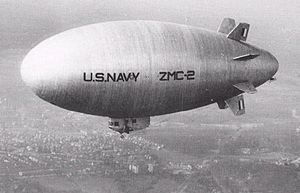| ZMC-2 | |
|---|---|
 | |
| General information | |
| Type | Metal-clad airship |
| National origin | United States |
| Manufacturer | Detroit Aircraft Corporation |
| Status | Scrapped |
| Primary user | U.S. Navy |
| Number built | 1 |
| History | |
| Manufactured | 1926–29 |
| First flight | August 19, 1929 |
| Retired | 1941 |
The ZMC-2 (Zeppelin Metal Clad 200,000 cubic foot capacity) was the only successfully operated metal-skinned airship ever built. Constructed at Naval Air Station Grosse Ile by The Aircraft Development Corporation of Detroit, the ZMC-2 was operated by the U.S. Navy at Lakehurst, New Jersey from 1929 until its scrapping in 1941. While at Lakehurst it completed 752 flights, and logged 2265 hours of flight time.
Operations
The airship was first flown on August 19, 1929, and transferred to Lakehurst, New Jersey in October 1929. The airship was nicknamed "the Tin Blimp". Its first Navy skipper was Red Dugan, who expressed reluctance at operating the airship, believing it unsafe. Dugan's concerns were proven wrong, though he later lost his life in the crash of another airship, Akron.
It was considered very successful as a sub-scale test vehicle, but the company that built it did not weather the Great Depression well, and by the time a successor might have been built, there was little interest in pursuing it. In the year before the Depression, the U.S. Army was seeking funding for an airship based on the ZMC-2, that would have been larger than the German Graf Zeppelin, and powered by eight engines of 600–800 hp (450–600 kW; 610–810 PS)}. The U.S. Army planned to use it as a tender for air-launched aircraft, similar to plans the U.S. Navy had for future dirigibles. The $4.5 million need for construction was never approved by Congress.
The ZMC-2 was operated with a zero internal pressure at speeds up to 20 miles per hour (32 km/h), sufficient for it to be considered a 'rigid' airship. With its low fineness ratio of 2.83, the ZMC-2 was difficult to fly. By 1936, the airship had travelled over 80,000 miles (130,000 km) with little sign of corrosion. In its lifetime the ZMC-2 logged 752 flights and 2265 hours of flight time. In its final years its use had dropped significantly. Between December 1938 and April 1941 it only logged five hours of flight time.
Considered by the Navy as too small for anti-submarine patrols, the aging ZMC-2 was decommissioned and scrapped in 1941 after nearly 12 years of service.
Operators
- USA
Specifications (ZMC-2)
General characteristics
- Crew: 2
- Capacity: 750 lb (340 kg) payload
- Length: 148 ft 11 in (45.4 m)
- Diameter: 53 ft 2 in (16.2 m)
- Height: 64 ft 6 in (19.66 m)
- Volume: 200,100 cu ft (5,667 m)
- Useful lift: 12,868 lb (5,837 kg)
- Powerplant: 2 × Wright J-5 Whirlwind 9-cyl. air-cooled radial piston engines, 220 hp (160 kW) each
Performance
- Maximum speed: 70 mph (112 km/h, 60 kn)
- Range: 675 mi (1,087 km, 587 nmi)
ZMC-2 in popular culture
The ZMC-2 plays a key role in the Clive Cussler novel Cyclops (1986) in which it is fictionally saved from scrapping and renamed Prosperteer.
See also
Notes
- ^ Morrow, Walker C. and Carl B. Fritsche. The Metalclad Airship ZMC-2. 1967.
- The 1897 airship of David Schwarz was the first airship that was metal-skinned, although Schwarz's ship had an internal framework rather than a monocoque design.
- Outlaw 2004, p. 7
- Pace, Montgomery, and Zitarosa 2003
- ^ Morrow and Fritsche 1967, p. v.
- "Metal Covered Airship To Carry Twenty Tons" 1931 , p. 552.
- Van Treuren 2007, p. 90
- Robinson, Douglas H. Giants in the Sky: A History of the Rigid Airship (Seattle: University of Washington Press, 1979), p. 225.
- Vaeth 2005, p. 69
References
- Althoff, William F. (2003). USS Los Angeles: The Navy's Venerable Airship and Aviation Technology. Dulles, Virginia: Potomac Books.
- "Metal Covered Airship To Carry Twenty Tons". Popular Mechanics. 55 (4): 552. April 1931. Retrieved 4 May 2011.
- Melton USNR, Lt. Comdr. Dick. (1970). The Forty Year Hitch. Wyandotte, Michigan: Publishers Consulting Services.
- Morrow, Walker C.; Carl B. Fritsche (1967). The Metalclad Airship ZMC-2. Grosse Ile: W.C. Morrow.
- Outlaw, Stanley; Hal Neubauer; Marcia Neubauer; Dwanda Outlawand (2004). A Pictorial History of Naval Air Station Grosse Ile, Michigan 1927 to 1969 Second edition. Charleston: University of South Carolina Press.
- Pace, Kevin; Ronald Montgomery; Rick Zitarosa (2003). Naval Air Station, Lakehurst. Charleston: Arcadia.
- Sullivan, George (1988). Famous Blimps and Airships. New York: Dodd, Mead & Co.
- Vaeth, Joseph Gordon (2005). They Sailed the Skies: U.S. Navy Balloons And the Airship Program. Annapolis: Naval Institute Press.
- Van Treuren, Richard G. (Spring 2007). "Making it Happen: Captain C.V.S. Knox and Aeronautical Evolution". Foundation. 28 (1): 89–98.
External links
- Lakehurst: International Airport (a picture of the ZMC-2 is near the bottom of the page) At the Internet Archive.
- ZMC-2 in hangar, under the nose of the Hindenburg At the Internet Archive.
- This has a short history of the ZMC-2 along with pictures of construction and flights of the ZMC-2 At the Internet Archive.
| Detroit aircraft | |||||||||||
|---|---|---|---|---|---|---|---|---|---|---|---|
| Civilian |
| ||||||||||
| Military |
| ||||||||||
| USN metal-clad airships | |
|---|---|
| ZMC-2 No other designations were assigned in this sequence |